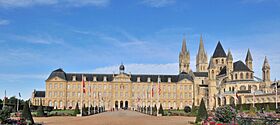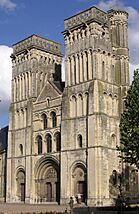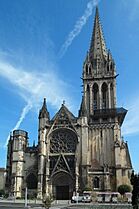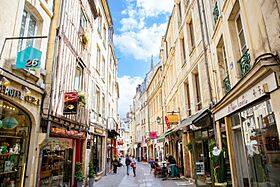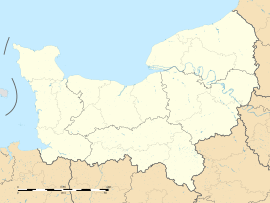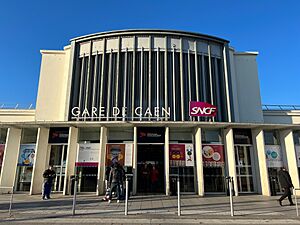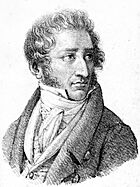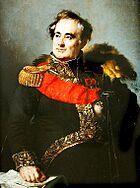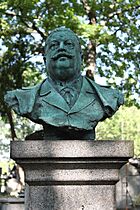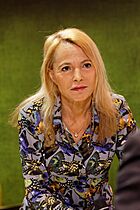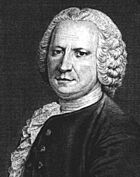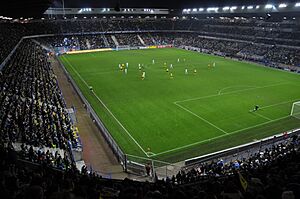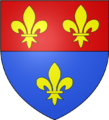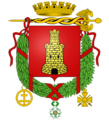Caen facts for kids
Quick facts for kids
Caen
Kaem (Norman)
|
||
|---|---|---|
|
Prefecture and commune
|
||
|
View of the Abbaye aux Hommes; The Abbaye aux Dames; Saint-Pierre Church; Rue Froide in the old town
|
||
|
||
| Country | France | |
| Region | Normandy | |
| Department | Calvados | |
| Arrondissement | Caen | |
| Canton | Caen-1, 2, 3, 4 and 5 | |
| Intercommunality | Caen la Mer | |
| Area
1
|
25.70 km2 (9.92 sq mi) | |
| • Urban | 173.6 km2 (67.0 sq mi) | |
| • Metro | 2,597 km2 (1,003 sq mi) | |
| Population
(2021)
|
108,200 | |
| • Density | 4,210.1/km2 (10,904/sq mi) | |
| • Urban
(2018)
|
205,708 | |
| • Urban density | 1,185.0/km2 (3,069.0/sq mi) | |
| • Metro
(2018)
|
469,526 | |
| • Metro density | 180.80/km2 (468.26/sq mi) | |
| Demonym(s) | Caennais | |
| Time zone | UTC+01:00 (CET) | |
| • Summer (DST) | UTC+02:00 (CEST) | |
| INSEE/Postal code |
14118 /14000
|
|
| Elevation | 2–73 m (6.6–239.5 ft) (avg. 8 m or 26 ft) |
|
| Website | caen.fr | |
| 1 French Land Register data, which excludes lakes, ponds, glaciers > 1 km2 (0.386 sq mi or 247 acres) and river estuaries. | ||
Caen is a city in northwestern France. It is about 15 kilometers (9 miles) from the coast. Caen is the main city of the Calvados area.
The city itself has over 105,000 people. Its larger urban area has about 470,000 people. This makes Caen the second largest urban area in Normandy. It is also the third largest city in all of Normandy.
Caen is located about 200 kilometers (124 miles) northwest of Paris. You can take a ferry from Caen (Ouistreham) to Portsmouth in England. The city is close to the D-Day landing beaches and popular resorts like Deauville.
Caen is famous for its old buildings. Many were built when William the Conqueror was king. He was even buried here. The city also saw heavy fighting during the Battle for Caen in 1944. This battle destroyed much of the city. Today, Caen has a special museum called the Mémorial de Caen. It is dedicated to peace and remembers the events of World War II.
Contents
- What's in a Name? The History of Caen's Name
- A Look Back: The History of Caen
- Caen's Location and Weather
- How Many People Live in Caen?
- Places to See in Caen
- How Caen is Governed
- Getting Around Caen
- Learning in Caen
- Caen's Economy
- Music and Theatre in Caen
- Famous People from Caen
- Caen's International Connections
- Sports in Caen
- Caen's Symbols
- Images for kids
- See also
What's in a Name? The History of Caen's Name
The name Caen first appeared in old documents around the year 1021. It was spelled in different ways, like Cadon or Cadumus.
Experts believe the name Caen comes from an old language called Gaulish. It might combine the words catu- (meaning "military activities") and magos (meaning "field"). So, Caen could mean "maneuver field" or "battlefield."
A Look Back: The History of Caen
Early Times in Caen
Caen was known as 'Catumagos' in Roman times. It was a small settlement back then. The city started to grow a lot in the 10th century. This was thanks to the support of the Dukes of Normandy.
Around 1060, William the Conqueror began building the Château de Caen. This castle became a very important place for the duke's court. William's wife, Duchess Matilda of Flanders, also started building the Abbey of Sainte-Trinité, Caen around the same time. She was later buried there. Caen then became the capital of Lower Normandy.
In 1204, Caen became part of the Kingdom of France.
Caen During the Hundred Years' War
In 1346, King Edward III of England attacked Caen. His army took the city in less than a day. They looted it and caused a lot of damage. About 3,000 citizens died. Only the castle held strong. The English left a few days later.
Later, in 1417, Henry V captured Caen after a long fight. The city was treated harshly. But in 1450, French forces took Caen back.
Caen in World War II
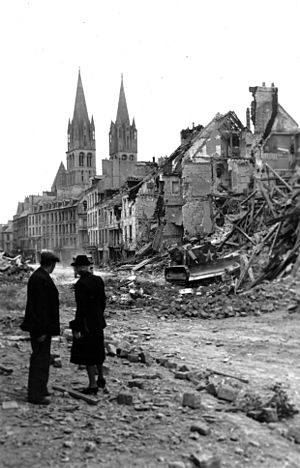
During World War II, German forces took control of Caen in 1940. In 1944, Allied forces invaded France. From June to August 1944, the British army fought to free Caen. This was called the Battle for Caen.
Allied bombing raids caused a lot of damage to the city. Many French civilians were hurt or killed. After the battle, much of Caen was destroyed. The city was rebuilt over many years, finishing in 1962.
Caen After the War
After the war, the city worked hard to rebuild. New neighborhoods and the university campus were constructed. This rebuilding took 14 years, from 1948 to 1962. Because of the war, Caen looks different from other old Norman towns.
Caen's Location and Weather
Caen is in an area with a lot of humidity. The Orne River flows through the city. Smaller rivers, called les Odons, also run through Caen. Most of these small rivers are now underground.
Caen is about 10 kilometers (6 miles) from the English Channel. A special canal, the Canal de Caen à la Mer, connects the city to the sea. This canal was built so ships could reach Caen at all times. It goes all the way to Ouistreham on the English Channel.
Caen's Climate
Caen has an oceanic climate. This means it has cool summers and mild winters. There is also a good amount of rain throughout the year.
| Climate data for Caen (CFR), elevation: 67 m (220 ft), 1991–2020 normals, extremes 1945–present, humidity 1961–1990 | |||||||||||||
|---|---|---|---|---|---|---|---|---|---|---|---|---|---|
| Month | Jan | Feb | Mar | Apr | May | Jun | Jul | Aug | Sep | Oct | Nov | Dec | Year |
| Record high °C (°F) | 16.8 (62.2) |
20.8 (69.4) |
24.9 (76.8) |
26.6 (79.9) |
30.4 (86.7) |
35.2 (95.4) |
40.1 (104.2) |
38.9 (102.0) |
33.5 (92.3) |
29.6 (85.3) |
21.6 (70.9) |
17.3 (63.1) |
40.1 (104.2) |
| Mean maximum °C (°F) | 13.8 (56.8) |
14.7 (58.5) |
19.0 (66.2) |
22.4 (72.3) |
25.6 (78.1) |
29.7 (85.5) |
31.3 (88.3) |
31.4 (88.5) |
27.4 (81.3) |
22.3 (72.1) |
17.1 (62.8) |
14.0 (57.2) |
33.0 (91.4) |
| Mean daily maximum °C (°F) | 8.3 (46.9) |
9.1 (48.4) |
11.7 (53.1) |
14.4 (57.9) |
17.4 (63.3) |
20.5 (68.9) |
22.9 (73.2) |
23.2 (73.8) |
20.4 (68.7) |
16.2 (61.2) |
11.8 (53.2) |
8.8 (47.8) |
15.4 (59.7) |
| Daily mean °C (°F) | 5.6 (42.1) |
5.9 (42.6) |
8.0 (46.4) |
10.0 (50.0) |
13.0 (55.4) |
15.9 (60.6) |
18.0 (64.4) |
18.3 (64.9) |
15.8 (60.4) |
12.5 (54.5) |
8.7 (47.7) |
6.1 (43.0) |
11.5 (52.7) |
| Mean daily minimum °C (°F) | 2.9 (37.2) |
2.8 (37.0) |
4.2 (39.6) |
5.5 (41.9) |
8.5 (47.3) |
11.2 (52.2) |
13.1 (55.6) |
13.3 (55.9) |
11.1 (52.0) |
8.8 (47.8) |
5.6 (42.1) |
3.3 (37.9) |
7.5 (45.5) |
| Mean minimum °C (°F) | −5.1 (22.8) |
−3.8 (25.2) |
−1.8 (28.8) |
0.2 (32.4) |
3.2 (37.8) |
6.2 (43.2) |
8.4 (47.1) |
8.3 (46.9) |
5.9 (42.6) |
2.1 (35.8) |
−1.0 (30.2) |
−4.0 (24.8) |
−6.7 (19.9) |
| Record low °C (°F) | −19.6 (−3.3) |
−16.5 (2.3) |
−7.4 (18.7) |
−5.7 (21.7) |
−0.8 (30.6) |
1.0 (33.8) |
4.7 (40.5) |
4.0 (39.2) |
1.8 (35.2) |
−3.7 (25.3) |
−6.8 (19.8) |
−11.0 (12.2) |
−19.6 (−3.3) |
| Average precipitation mm (inches) | 63.1 (2.48) |
52.8 (2.08) |
49.7 (1.96) |
53.4 (2.10) |
59.4 (2.34) |
58.0 (2.28) |
51.1 (2.01) |
59.6 (2.35) |
54.3 (2.14) |
78.9 (3.11) |
78.7 (3.10) |
81.3 (3.20) |
740.3 (29.15) |
| Average precipitation days (≥ 1.0 mm) | 11.6 | 11.2 | 10.0 | 10.0 | 9.5 | 8.6 | 8.0 | 8.3 | 9.1 | 12.2 | 13.4 | 14.2 | 126.1 |
| Average snowy days | 3.4 | 3.8 | 2.3 | 0.9 | 0.1 | 0 | 0 | 0 | 0 | 0 | 0.9 | 2.2 | 13.6 |
| Average relative humidity (%) | 86 | 84 | 82 | 80 | 81 | 82 | 81 | 81 | 83 | 86 | 86 | 87 | 83 |
| Mean monthly sunshine hours | 70.5 | 90.2 | 130 | 179.1 | 203.4 | 212.6 | 218.5 | 204.8 | 170.9 | 117.1 | 81.9 | 67.2 | 1,746.2 |
| Source 1: Météo France | |||||||||||||
| Source 2: Meteociel(sun) Infoclimat.fr (relative humidity 1961–1990) (mean max/min) NOAA(snowy days 1961-1990) | |||||||||||||
How Many People Live in Caen?
The numbers below show how many people have lived in Caen over the years. In 1952, a small town called Venoix became part of Caen.
| Historical population | |||||||||||||||||||||||||||||||||||||||||||||||||||||||||||||||||||||||||||||||||||||||||||||||||||||||||||||||||||
|---|---|---|---|---|---|---|---|---|---|---|---|---|---|---|---|---|---|---|---|---|---|---|---|---|---|---|---|---|---|---|---|---|---|---|---|---|---|---|---|---|---|---|---|---|---|---|---|---|---|---|---|---|---|---|---|---|---|---|---|---|---|---|---|---|---|---|---|---|---|---|---|---|---|---|---|---|---|---|---|---|---|---|---|---|---|---|---|---|---|---|---|---|---|---|---|---|---|---|---|---|---|---|---|---|---|---|---|---|---|---|---|---|---|---|---|
|
|
||||||||||||||||||||||||||||||||||||||||||||||||||||||||||||||||||||||||||||||||||||||||||||||||||||||||||||||||||
| Source: EHESS and INSEE (1968-2017) | |||||||||||||||||||||||||||||||||||||||||||||||||||||||||||||||||||||||||||||||||||||||||||||||||||||||||||||||||||
Places to See in Caen
Caen Castle
The Château de Caen was built around 1060 by William the Conqueror. He was the one who successfully conquered England in 1066. This castle is one of the biggest medieval fortresses in Western Europe. It was very important for the Norman rulers.
Caen Castle became part of the French Crown in 1204. It was used as a military base even during World War II. Today, the castle is a museum. It holds the Musée des Beaux-Arts de Caen (Museum of Fine Arts) and the Musée de Normandie (Museum of Normandy). They also have many special art and history exhibits.
Famous Abbeys
William the Conqueror ordered two abbeys to be built. This was to show he was sorry for marrying his cousin.
- Église St.-Étienne: This was once called the Abbaye aux Hommes (Men's Abbey). It was finished in 1063. The city's current town hall is built next to it.
- Église de la Ste.-Trinité: This was once called the Abbaye aux Dames (Women's Abbey). It was finished in 1060.
Other Interesting Places
- Jardin botanique de Caen: A beautiful old botanical garden.
- Church of Saint-Pierre: A historic church in the city.
- Mémorial pour la Paix: This "Memorial for Peace" was built in 1988. It is a museum that tells the story of events leading up to and after D-Day. It makes you think about peace. The museum also shows Nobel Peace Prize winners.
- Parc Festyland: An amusement park located just west of Caen. About 110,000 people visit it every year.
- Colline aux Oiseaux: A lovely flower park.
How Caen is Governed
Caen is led by a mayor. Aristide Olivier is the current mayor, serving from 2024.
In 1952, the small town of Venoix joined Caen.
Caen is part of a larger group of towns and villages called "Caen la Mer." This group works together on things like public services. It includes about 29 towns and villages.
Getting Around Caen
Public Transport
City Transport Network
Twisto is Caen's public transport system. It has about sixty bus lines and three tramway lines. The current Caen tramway opened in 2019. Before that, Caen had a different guided bus system. The city also had trams from 1860 to 1937.
Trains
Caen railway station connects Caen to many parts of France. You can take trains to Paris, Rouen, Le Mans, and Cherbourg. Caen station is the second busiest train station in Normandy.
Air Travel
Caen - Carpiquet Airport is the largest airport in Normandy. It handles many passengers and flights each year. You can fly from Caen to several French cities.
Water Travel
Caen has a large port in Ouistreham. This port is at the end of the Caen Canal, where it meets the English Channel. You can take a ferry from Ouistreham to Portsmouth, England. The ferry terminal is about 15 kilometers (9 miles) from Caen. There is also a bike path from Caen to Ouistreham.
Road Travel
Caen is connected to other parts of France by major roads called motorways. The A13 goes to Paris. The A84 goes to Brittany and Southern France. The city has a ring-road, the N814, which goes around it. This road includes a large bridge called the fr:Viaduc de Calix.
Learning in Caen
The University of Caen has about 34,000 students. It is one of the oldest universities in France, founded in 1432. Caen is ranked as the 18th biggest student city in France. The university is well-known and is ranked 16th in France.
Caen also has other schools. These include a school for fine arts and engineering schools. A business school, the École de management de Normandie, also has a campus here.
Caen's Economy
The company Agrial has its main office in Caen. Agrial is a large cooperative that works with farms. They process vegetables, apples for cider, milk, poultry, and meat. Agrial has 12,000 employees.
Music and Theatre in Caen
The Théâtre de Caen (built in 1963) is home to a famous Baroque music group. This group is called Les Arts Florissants. It was started in 1979 by conductor William Christie.
Famous People from Caen
Many notable people were born in or came from Caen.
Public Service
- Robert, 1st Earl of Gloucester (around 1090–1147): An important son of King Henry I of England.
- Charlotte Corday (1768–1793): Known for her role during the French Revolution.
- Eugène Poubelle (1831–1907): A lawyer who introduced waste containers to Paris.
- Marie-Pierre Kœnig (1898–1970): A French general who led forces in World War II.
The Arts
- François de Malherbe (1555–1628): A famous French poet and critic.
- Daniel Auber (1782–1871): A well-known composer.
- Léa Drucker (born 1972): A French actress.
- Orelsan (born 1982): A popular rapper, songwriter, and film director.
Science and Business
- Pierre Varignon (1654–1722): A mathematician who invented a tool for measuring pressure.
- Guillaume-François Rouelle (1703–1770): A chemist.
- André-Louis Danjon (1890–1967): An astronomer.
Sports
- Jean-Pierre Jaussaud (1937–2021): A racing driver who won the 24 Hours of Le Mans race twice.
- Bruno Massot (born 1989): A pair skater who won a gold medal at the 2018 Winter Olympics.
- Youssef El-Arabi (born 1987): A footballer who has scored many goals.
Caen's International Connections
Caen is twinned with several cities around the world. This means they have special friendly relationships.
 Alexandria, United States
Alexandria, United States Nashville, United States
Nashville, United States Ohrid, North Macedonia
Ohrid, North Macedonia Portsmouth, England, United Kingdom
Portsmouth, England, United Kingdom Reșița, Romania
Reșița, Romania Thiès, Senegal
Thiès, Senegal Würzburg, Germany
Würzburg, Germany Anzio, Italy
Anzio, Italy
Sports in Caen
Caen has been a stop for the Tour de France bicycle race 15 times. The city also hosted the EuroBasket 1983 basketball tournament.
Caen has a football (soccer) team called SM Caen. As of 2024, the famous footballer Kylian Mbappé owns the team. The Drakkars de Caen is Caen's ice hockey team. In 2014, Caen hosted the 2014 FEI World Equestrian Games, a big horse riding event.
Caen's Symbols
Coat of Arms
Current arms: The city's coat of arms shows a golden castle with one tower on a red background.
Under the old French system, the arms were different. During the First French Empire, they also changed. Today, the city uses its original arms from the 13th century.
-
Arms suggested to Napoleon in 1809, but not used. -
Arms used during the First French Empire.
Motto
Caen does not have a motto today. But it used to have one before the French Revolution. It was: Un Dieu, un Roy, une Foy, une Loy. This means "One God, one King, one Faith, one Law."
Images for kids
See also
 In Spanish: Caen para niños
In Spanish: Caen para niños


